Exploring the Hydrofoil Surfboard in Kiteboarding
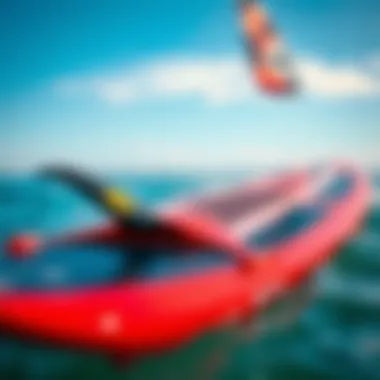
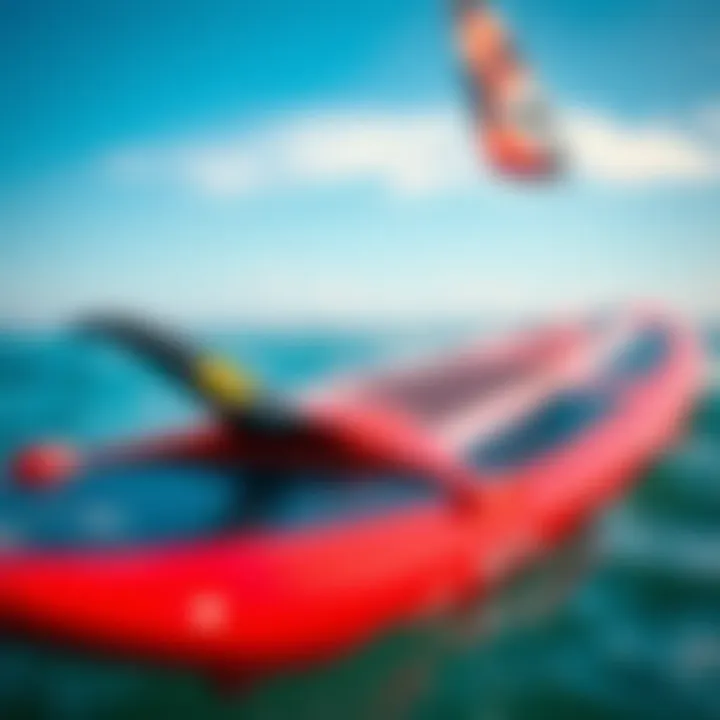
Intro
As kiteboarding enthusiasts look to push the boundaries of their sport, hydrofoil surfboards are becoming increasingly prominent. These innovative boards lift riders out of the water, minimizing drag and enabling smooth rides even in light winds. This shift marks a significant evolution in kiteboarding practices, necessitating a fresh look at gear selection, skill development, and the overall experience on the water. The aim here is to provide an in-depth exploration of hydrofoil surfboards, guiding both novices and seasoned kiteboarders alike.
Gear Selection
Choosing the right gear is crucial for maximizing the hydrofoil experience. With various factors in play, understanding the specifics can save a world of trial and error.
Types of Kites
When it comes to kites suitable for hydrofoiling, size matters. Riders should generally opt for kites that are larger than their typical choices used for traditional kiteboarding. The reason is straightforward: larger kites catch more wind, providing the lift needed to take off smoothly with minimal effort. Here are some types to consider:
- Foil Kites: Known for their efficiency, these kites excel in light wind conditions. They are generally less prone to overshooting and are easier to manage during take-off and landing.
- Leading Edge Inflatable (LEI) Kites: While these kites often deliver strong performance in varied conditions, they may require a bit more skill to handle effectively while hydrofoiling.
It's essential to check wind conditions when choosing kites, as a kite that's too large might lead to an overwhelming ride.
Choosing the Right Board
For hydrofoiling, board selection can impact performance drastically. While there are countless models available, focus on these aspects to narrow your options:
- Foil Size: A larger foil typically provides more lift, making it easier to get airborne, perfect for beginners. Intermediate to advanced riders might prefer smaller foils for enhanced maneuverability.
- Board Volume: Boards with higher volumes float better, aiding in stability during take-off. Look for something that suits your weight, as heavier riders will need more volume.
- Shape and Design: The shape can affect how well the board cuts through the water and behaves on landings. A wider tail usually enhances stability, while a narrower aspect allows quicker turns.
By taking these factors into account, anyone looking to transition into hydrofoil kiteboarding can make informed decisions that cater to their needs and preferences.
Skill Development
Transitioning to hydrofoil kiteboarding involves honing specific techniques. It's not just about having the right gear; without the necessary skills, even the best boards can feel like a burden.
Essential Techniques
Mastering a few core techniques is vital for a smooth ride. A couple of essential points to consider:
- Begin by Practicing in Controlled Environments: Start in flat, open water with steady winds to get accustomed to the sensation of being airborne. The more comfortable you are, the faster you'll progress.
- Weight Distribution: Proper weight distribution is key to maintaining balance. Keep your weight centered over the board and shift it forward while taking off.
Progression Tips
Improvement comes with practice. Here are some tips to keep in your back pocket:
- Start with Small Kites: As confidence grows, gradually move towards larger kites to help gain speed without losing control.
- Focus on Controlled Take-Offs: Instead of attempting steep climbs, aim for gradual lifts until you’re comfortable with your balance.
- Take Lessons from Experienced Riders: Whether through an instructor or experienced friends, observing and receiving feedback can fast-track your learning curve.
"Hydrofoiling isn’t just a sport; it’s a dance with the wind and water. Master it, and the world feels very different beneath your board."
Thinking ahead, understanding gear impacts not just performance but enjoyment as you engage in this thrilling water sport. Preparing comprehensively means diving in with knowledge and confidence.
Prolusion to Hydrofoil Surfboards
Hydrofoil surfboards represent a significant shift in the realm of kiteboarding, blending cutting-edge technology with age-old board sports. These sleek, hydrodynamic designs are not just a gimmick; they open up a world of possibilities for riders, transforming the way they engage with water. The curiosity surrounding hydrofoil technology is pulling in enthusiasts and pros alike, and it’s essential to understand why this innovation has taken the kiteboarding community by storm.
Understanding Hydrofoil Technology
At its core, hydrofoil technology revolves around a unique set of components known as foils—essentially wings submerged beneath the board. As the rider gains speed, these foils lift the board above the water's surface, reducing drag and allowing for smoother rides even in less-than-ideal wind conditions. The mechanics behind foils can be complex, yet they follow a simple principle: lift. As water flows over the wings, it creates a pressure differential that lifts the board, transforming the experience from just skimming the surface to a rhythm of gliding above it.
This elevation not only enhances speed but also significantly alters the experience of riding over choppy waters, giving a far more stable and controlled ride. The technology has sparked a new conversation about performance and adaptability for different skill levels. Riders are discovering that hydrofoils can make their sessions more enjoyable, particularly when the winds are lighter than usual. Additionally, advancements in materials and construction have made these boards lighter and more robust, helping to cater to the demands of rigorous riding.
The Rising Popularity in Kiteboarding
In the ever-evolving world of kiteboarding, hydrofoil surfboards are rapidly gaining traction. The appeal is multifaceted; riders are drawn to the freedom and versatility these boards offer. As kiteboarding enthusiasts yearn for new thrills, hydrofoils are being embraced as a fresh way to explore flat water and waves alike.
Many factors contribute to this rising popularity:
- Accessibility: With hydrofoils, riders can experience thrilling speed and unique sensations without requiring gale-force winds. This opens the sport up to a wider audience, including newcomers looking for more manageable conditions.
- Terrain Versatility: Hydrofoils adapt well to various water types. Whether you’re tackling coastline waves, flat lakes, or even rivers, the ability to cruise effortlessly is a major selling point.
- Community and Culture: The growing community around hydrofoiling is becoming increasingly supportive. Online forums and social media platforms, like Reddit and Facebook, are buzzing with tips, shared experiences, and educational content that help newcomers integrate into the sport.
The excitement surrounding hydrofoiling is palpable, making it clear that it’s not just a trend—it’s a burgeoning culture within kiteboarding.
As we delve deeper into the intricacies of the hydrofoil surfboard, from its anatomy to the advantages it brings, kiteboarding enthusiasts are sure to find a wealth of information that not only answers their questions but enriches their riding experiences. The blend of tech and technique heralds a new era in the sport, providing opportunities for exploration like never before.
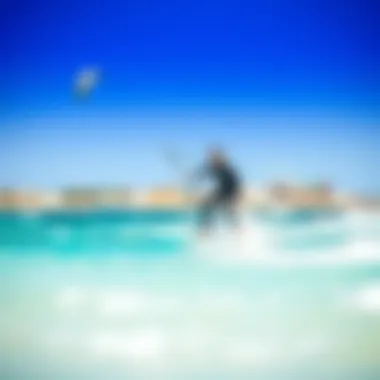
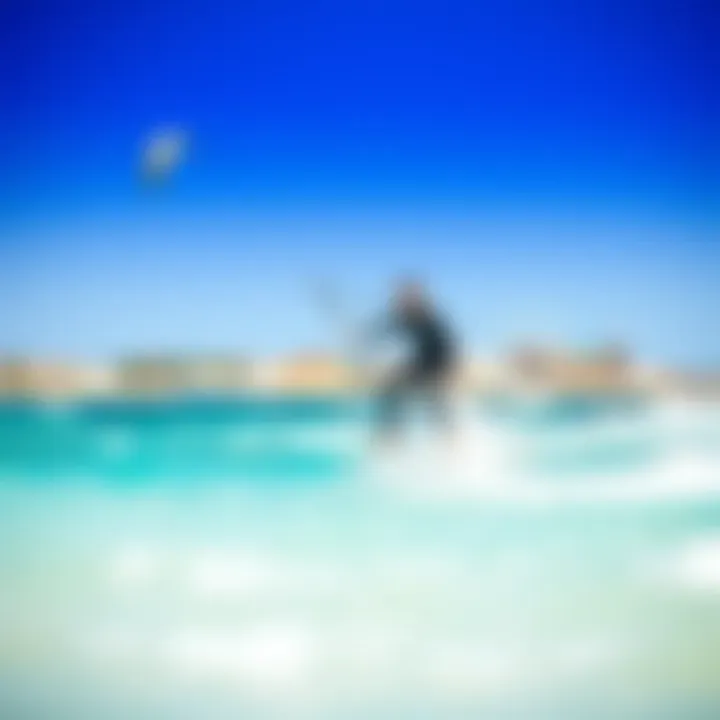
The Anatomy of a Hydrofoil Surfboard
Understanding the anatomy of a hydrofoil surfboard is crucial for anyone looking to harness the power of this innovative riding experience. A hydrofoil surfboard operates by lifting above the water's surface, which minimizes drag and enhances performance. Knowing what makes up a hydrofoil surfboard not only aids in better decision-making during gear selection, but it also helps riders understand how each component contributes to their overall experience on the water.
Key Components of Hydrofoils
The main components that constitute a hydrofoil surfboard work in tandem to create a seamless ride. Here’s a closer look at each element:
- Mast: The mast is the vertical pillar that connects the board to the hydrofoil wings submerged under the water. Its height can vary, and this affects stability and how high the rider can fly above the waves.
- Wings: The wings are the parts that actually lift the board out of the water. The size, shape, and angle of the wings determine their lift and drag characteristics. A larger wing will typically offer more lift at low speeds, which is beneficial for beginners, while smaller wings are favored by advanced riders seeking speed and agility.
- Fuselage: This is the horizontal component that connects the mast to the wings. Its design influences the overall stability of the hydrofoil. A longer fuselage can provide more balance, while a shorter one offers better maneuverability.
- Surfboard Shape: The board's design shapes how it interacts with the water. It should ideally have a balanced volume and outline to ensure a smooth ride whether you’re flying or just skimming.
"The components of a hydrofoil are like the instruments in an orchestra; each plays its part in creating a harmonious experience on the water."
These components, combined thoughtfully, not only make riding smoother but also enhance user control, giving beginners the confidence they need while offering advanced users the precision they crave.
Surfboard Design: How Shape Affects Performance
The design of the surfboard, particularly its shape, holds paramount importance in its performance. Subtle variations can dictate how well the hydrofoil interacts with the water.
- Rockers: The curvature from nose to tail greatly affects the way a board paddles and generates speed. A flatter rocker can lead to faster rides, while a pronounced rocker provides excellent maneuverability.
- Width: A wider board typically offers more stability, which is crucial when learning to ride. However, for the seasoned kiteboarder looking to enhance performance in turns or during jumps, a narrower design could be the better choice.
- Thickness: This determines buoyancy. Thicker boards can float better and are easier to control for beginners, but they might create more drag, which experienced surfers need to avoid.
- Tail Shape: Different tail designs can dramatically change how a board reacts in choppy conditions. A square tail offers stability and speed, while a rounded tail provides more maneuverability.
Choosing the right combination of these design elements can drastically improve your experience on the water, allowing for a ride that closely matches your skills and ambitions.
.
Advantages of Hydrofoil Surfboarding
Hydrofoil surfboarding has opened a new world of possibilities for kiteboarders, revolutionizing the sport by introducing a set of benefits that traditional surfing just can't compete with. As more enthusiasts venture into hydrofoiling, understanding its advantages becomes crucial, especially when it comes to honing one’s skills and maximizing enjoyment on the water. From performance enhancements to environmental considerations, the benefits of hydrofoil surfboarding merit detailed exploration.
Enhanced Performance in Low Wind Conditions
One of the standout advantages of hydrofoil surfboards is their remarkable ability to perform efficiently in low wind conditions. Traditional kiteboarding can be all but impossible when the wind drops below a certain threshold, but hydrofoils can glide above the water's surface, harnessing even the slightest breeze. Instead of feeling stuck on the beach, riders can take advantage of winds as low as 5 knots.
This capability is due to the foils lifting the board out of the water, decreasing drag significantly. When a hydrofoil is properly tuned, the board can catch wind more effectively, resulting in a smoother and more controlled ride. This characteristic not only makes hydrofoiling accessible for longer periods but also expands the horizons for riding locales, allowing aficionados to explore spots that might otherwise be deemed unsuitable due to erratic wind patterns.
Increased Speed and Maneuverability
Hydrofoil surfboards don’t just perform in low winds; they excel in delivering increased speed and maneuverability. Unlike their traditional counterparts, which may struggle to pick up speed or feel cumbersome when performing turns, the hydrofoil allows riders to carve through the water with remarkable agility.
This speed comes from the unique lift generated by the hydrofoil, enabling the rider to accelerate quickly. A well-tuned hydrofoil set-up can feel like being on a magic carpet, gliding seamlessly across the water. For kiteboarders, this means effortless transitions, sharp turns, and thrilling jumps that amplify the riding experience.
Furthermore, maneuverability isn't just about going faster. It’s about the feeling of control over the board—navigating tight spaces and catching those little gusts becomes second nature as riders develop their skills on hydrofoils. With practice, riders can execute spins, loops, and tricks that can often seem daunting on traditional boards.
"Hydrofoils turn the water into a playground—it’s like dancing on air."
Reduced Impact on Waves and Water Conditions
Another compelling advantage of hydrofoil surfboarding lies in its reduced impact on waves and water conditions. As hydrofoils elevate the board above the surface, they minimize disruption to the water below. This not only allows for a gentler experience for the rider but also contributes to a more sustainable approach to kiteboarding.
Waves, particularly in fragile marine environments, can be easily disturbed by conventional boards, leading to erosion and habitat degradation. Hydrofoils, in contrast, glide over the crests, preserving the integrity of the surf zone. By choosing hydrofoil surfboarding, practitioners can engage in this exhilarating sport while being stewards of the environment.
The ability to ride over choppy waters, light winds, or even flat lakes broadens the appeal of hydrofoiling to a variety of locations where traditional kiteboarding might not be feasible. Riders can enjoy an unobtrusive connection to nature, amplifying the experience of being out on the water without leaving behind negative footprints.
In summary, the advantages of hydrofoil surfboarding are not just significant but transformative. With enhanced performance in low wind conditions, increased speed and maneuverability, and a reduced ecological footprint, hydrofoils present a compelling case for kiteboarders looking to push their boundaries while being mindful of their surroundings.
Techniques for Hydrofoil Riding
When it comes to hydrofoil riding, mastering the right techniques is absolutely pivotal. Getting acquainted with these techniques not only boosts confidence but allows kiteboarders to fully exploit the unique capabilities of a hydrofoil surfboard. Understanding how to maneuver, balance, and adjust your riding style will drastically enhance your experience on the water, leading to more dives and less face-plants.
In this section, we’ll cover fundamental maneuvers needed for beginners, as well as some advanced techniques designed to truly elevate your riding to the next level.
Getting Started: Basic Maneuvers
So, you’ve grabbed your hydrofoil and you’re eager to hit the water. The first thing you should realize is that balance is crucial. Unlike traditional kiteboarding, where the board rides on water, a hydrofoil lifts out of the water, creating a completely different dynamic.
Some basic maneuvers you’ll want to start with include:
- Launching and Landing: These initial steps are your groundwork. Ensure that your kite is positioned properly before you even think about coming out of the water. Your body position should be slightly bent at the knees, ready to adapt as the hydrofoil begins to lift.
- Controlling Your Speed: Gaining lift and control requires an understanding of your speed. Too slow, and you’ll plop back in the water; too fast, and you risk losing control. Finding that sweet spot is the name of the game.
- Weight Distribution: Shift your weight towards your back foot as the board begins to rise. This addressing of weight helps to maintain lift while you ride. It can feel like balancing on a seesaw – too much pressure in either direction and you’ll end up in the drink.
"Hydrofoils require not just strength, but finesse. Too rigid can be just as ineffective as being too relaxed."
These basic maneuvers form the backbone of hydrofoil riding. They take time and practice, but they pave the way to the more exciting, advanced techniques just around the corner.
Progressing to Advanced Techniques
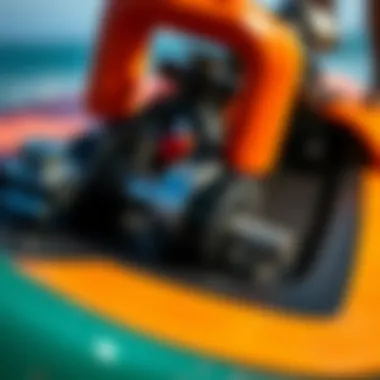
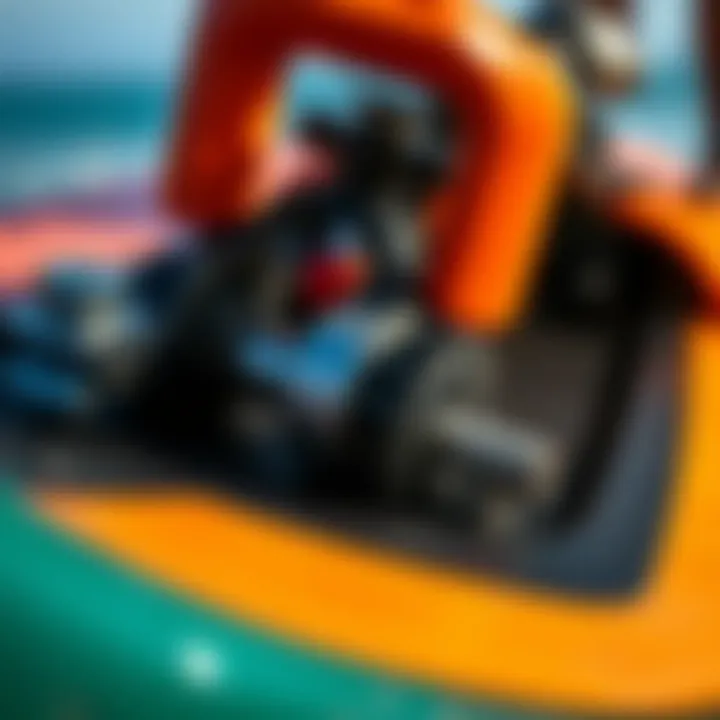
Once you’ve got the basics down, it’s time to delve into the more thrilling aspects of hydrofoiling. These advanced techniques can add a whole new level to your riding experience and include both tricks and refined maneuvers that offer tactical advantages during a session.
- Carving Turns: Learning to carve is essential for flipping and changing directions fluidly. Start wide and gradually tighten your turn while shifting your body weight to help maintain lift. This can give your ride a dynamic flair that feels distinctly different from traditional kiteboarding.
- Jumps and Airs: Ah, the crown jewel of hydrofoil riding. Performing jumps requires not only skill but precise timing. Begin by crouching before the jump, driving your board down and then propelling upwards as you extend your legs. Understanding the wind conditions is crucial here; being out of sync can easily lead to uncomfortable landings.
- Riding Switch: This maneuver involves changing your stance to ride with the opposite foot forward. While it may sound simple, riding switch on a hydrofoil demands balance and a keen sense of flow, making it an impressive trick in the eyes of other riders.
- Using Ocean Swells: This is where hydrofoil magic truly comes to life. Learning to read the ocean and using swells to ride is an exhilarating experience. The lift helps you stay above chop and makes for smoother surfing over bumps.
Mastering these advanced techniques doesn’t happen overnight; it requires patience, practice, and quite a few spills. Yet, pushing through the initial challenges will pay off immensely, transforming your riding experience and establishing deeper connections with both your gear and the elements.
Selecting Hydrofoil Gear
The right gear can make or break your experience as a hydrofoil kiteboarder. It’s not just about being stylish or on-trend; the equipment you choose plays a crucial role in your performance and comfort on the water. With the variety of hydrofoils and surfboards available today, understanding what to look for is essential.
Choosing the Right Size and Style
Selecting the appropriate size and style of your hydrofoil and board is fundamental to enhance the riding experience. Everything from your weight to the type of water conditions you'll encounter can influence these choices.
- Posture and Agility: Lighter riders typically benefit from a smaller board, allowing for easier maneuverability. On the other hand, a heavier individual may find better stability with a larger board.
- Foil Size: It's similar; larger foils lift more efficiently but can be harder to control in choppy waters. Keeping balance is key, especially for beginners.
- Board Shape: Different shapes affect performance. For instance, a wider board provides more stability, while a longer board offers greater speed.
In essence, knowing your riding style—whether you prefer cruising or aggressive turns—will guide your selection.
Essential Accessories for Hydrofoil Kiteboarding
Even if you have the best hydrofoil and surfboard, without the right accessories, you might struggle. Some essentials to consider:
- Safety Gear: A helmet and impact vest can be lifesavers. Avoiding injuries is paramount, especially when learning or experimenting with new tricks.
- Footstraps: These ensure your feet stay secured to the board, especially when you're attempting jumps or hard turns. A good fit is required, so try a few options before settling.
- Paddle: In cases of falling off, a paddle can help you navigate back to your board or shore swiftly. Plus, it helps when you want to glide through calm waters without wind.
"Investing in quality gear is not just about spending money; it's about ensuring longevity, safety, and superior performance on the waves."
Ultimately, selecting hydrofoil gear isn't a one-size-fits-all situation. It's about understanding your needs, preferences, and skill level. The right choices can lead to better progression in the sport while ensuring you have plenty of fun moments out on the water.
Safety Considerations in Hydrofoiling
When venturing into the world of hydrofoil surfboards, understanding safety considerations becomes paramount. Hydrofoiling can be exhilarating and offers a unique experience on the water, but it comes with its own set of risks and challenges. Prioritizing safety helps ensure that every ride is not only enjoyable but also secure. The following subsections delve into the intricacies of safety, examining the risk factors and best practices essential for safe hydrofoil riding.
Understanding Risk Factors
Hydrofoil surfboarding introduces various risk factors that both novice and experienced riders should recognize.
- Fall Risk: The heightened speed and elevation cause riders to fall unpredictably. The board can easily slip out from under them due to sudden shifts in wind or water conditions. Proper technique and careful control are necessary to mitigate these falls, which can lead to injuries.
- Collision Hazards: Riding in crowded areas increases the likelihood of collisions with other surfers, boats, or even obstacles beneath the water. Riders must maintain situational awareness and avoid busy zones when possible, especially as visibility can be limited.
- Environmental Factors: Changes in weather conditions can create dangerous riding situations, such as chop in the water, strong currents, or lightning storms. Monitoring weather conditions ahead of time and having an escape plan can be invaluable.
- Equipment Failure: Hydrofoils are complex structures that require ongoing maintenance. Any malfunction—like a loose connection or damaged wing—can result in serious accidents. Regular checks can help keep gear in optimal condition.
"Awareness leads to safety. It's not just about how fast you ride, but how well you read the conditions of your environment and equipment."
Best Practices for Safe Riding
To further navigate the risks associated with hydrofoiling, adopting best practices becomes essential. By being proactive, riders can create a safer experience:
- Wear Appropriate Gear: Always don a helmet and impact vest. These pieces of equipment can significantly reduce the severity of injuries in case of a fall.
- Practice in Controlled Environments: Beginners should start practicing in calm, shallow waters away from busy beaches. This allows for a safe space to learn and makes it easier to recover from falls without the worry of smashing into something hard.
- Be Mindful of Others: Constantly scan the area for other water users. This can help avoid collisions and ensure everyone on the water is safe. Riders should signal their intentions and communicate with others when necessary.
- Know Your Limits: It’s easy to get carried away with the excitement. Riders must recognize when they are pushing themselves too hard or riding conditions that exceed their current skill level. Listening to one’s own body and instincts doesn’t just prevent accidents but enhances overall enjoyment.
- Stay Updated with Safety Protocols: Engaging with community resources, local regulations, and safety courses can provide the latest information. Organizations that specialize in water sports often have resources and guides detailing best practices.
By implementing these safety considerations and practices, riders can enjoy the thrilling experience of hydrofoiling while minimizing risks and ensuring a safer adventure on the water.
Challenges of Hydrofoil Surfboarding
Hydrofoil surfboarding offers a revolutionary experience, yet it’s not without its hurdles. Understanding these challenges is vital for any kiteboarder looking to embrace this innovative style. The intricacies of hydrofoil technology present unique complications that can affect performance, safety, and riding enjoyment. By delving into these challenges, one gains insight into how to effectively navigate them and enhance their overall experience.
Navigating Technical Difficulties
When stepping onto a hydrofoil surfboard, the first thing one might notice is the steep learning curve. Getting the board to lift off the water requires precise control of balance, kite position, and speed. This isn’t just a minor adjustment; it’s akin to trying to master an entirely different craft altogether. The main technical hurdles include:
- Balancing Act: Maintaining equilibrium while the board is up in the air can feel like walking a tightrope. A slight miscalculation could result in a nose dive or an ungraceful fall.
- Kite Control: Effective operation of the kite is essential. As the foil lifts, being in tune with the kite's power becomes paramount. A simple gust can wobbify your stance.
- Understanding Lift Dynamics: Not every rider understands the physics behind hydrofoil lift. Familiarity with how speed and angle affect the lift helps riders mitigate crashes.
Considering these challenges, training with someone experienced or participating in classes can make a world of difference. Like anything else, taking time to practice improves competence. It’s wise to practice these techniques in smoother water and lighter winds to gain confidence before facing more challenging conditions.
Environmental Factors and Conditions
Wind and water conditions play a significant role in the hydrofoiling experience. Mother Nature can surprise even the seasoned kiteboarder, making it crucial to understand how different elements impact your ride. Some common environmental challenges include:
- Wind Variability: Hydrofoils thrive in steady winds. However, sudden gusts or lulls can lead to instability. Knowing how to read the wind is half the battle.
- Water Surface Conditions: Choppy waters might feel exhilarating at first but can lead to difficulties during take-off and landings. This is where choosing the right time and place for riding becomes key.
- Obstacles in the Water: Hidden dangers like rocks or algae patches can pose a significant risk. Riders need to be aware of their surroundings at all times, especially when the board is just getting off the surface.
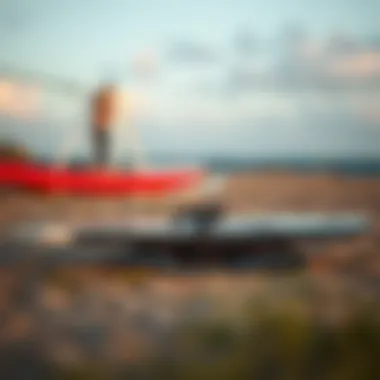

Environmental Impact and Sustainability
The topic of environmental impact and sustainability holds an increasingly significant seat at the table in the world of kiteboarding, especially as more enthusiasts turn their eyes to hydrofoil surfboards. The integration of eco-friendly practices and materials is not just a nicety but a necessity for the future of the sport. As the waves rise and fall, so too must our commitment to protecting the waters that we love. Understanding the ecological footprint of our gear and practices is crucial in navigating the changing tides of kitesurfing culture.
Hydrofoils present a fascinating blend of advancement and responsibility. These surfboards, designed with innovation in mind, also urge us to think critically about how they impact our environment. Today, more brands embrace sustainable manufacturing processes, utilizing recycled materials and organic substances that lessen the toll on our ecosystems.
Additionally, the allure of hydrofoiling rests on its ability to utilize lower wind conditions. This not only broadens access to kiteboarding experiences but also resonates with the desire to minimize water disruption. With that, kiteboarders are called to respect marine life and local environments as they carve through the surface, leading to a more conscientious riding culture.
"Sailing over water could be a privilege to protect, not just a pastime to enjoy."
Eco-Friendly Materials and Manufacturing Practices
Today's manufacturers are taking strides to integrate eco-friendly materials into their hydrofoil surfboard designs. Commonly, the use of materials such as bamboo and recycled plastics is becoming the norm rather than the exception. For instance, certain brands have developed foils made with biodegradable resins that break down naturally when they reach the end of their lifecycle.
Moreover, the production processes are being closely examined for sustainability. By sourcing materials locally, some companies aim to reduce their carbon footprint while also supporting local economies. Key practices include:
- Utilizing recycled aluminum for frame construction
- Incorporating sustainable wood planks for the board itself
- Applying water-based adhesives to avoid toxic waste
It's not just about the materials; the awareness around reducing waste in production methods is growing. Manufacturers are increasingly opting for a zero-waste approach, where every scrap and leftover is either reused or responsibly discarded. This creates a cycle, ensuring that old boards do not contribute to clutter but rather find new life in other sectors.
Promoting Responsible Kiteboarding Practices
As awareness rises, so does the call for kiteboarders to embrace responsible practices, not just in how they treat the water, but also how they treat their gear and the culture surrounding the sport. Educational workshops and community initiatives are being launched to encourage enthusiasts to take an active role in protecting marine environments.
Key practices to promote responsible kiteboarding include:
- Participating in beach clean-ups, enhancing local habitats while fostering community
- Respecting wildlife and habitats by maintaining an appropriate distance from sensitive marine areas
- Sharing knowledge with fellow riders about sustainable choices, spreading the seeds of eco-consciousness
This movement aims to create a culture of mindfulness among kiteboarders. The goal is to ensure that as the sport grows, it doesn’t leave behind a trail of environmental degradation. Riding hydrofoils can be more than just a thrilling experience; it can be a platform for change in a flourishing community.
In the ever-evolving landscape of kiteboarding, aligning with sustainability can elevate the sport's profile and secure its future. By integrating mindful practices into our routines, we’re not only riding the waves but also nurturing the very waters we thrive upon.
The Future of Hydrofoiling in Kiteboarding
The continuing evolution of hydrofoil technology is reshaping the landscape of kiteboarding, promising numerous enhancements in both performance and accessibility. For kiteboarders, the future holds exciting possibilities as the sport integrates advanced hydrofoil innovations. One significant benefit lies in increased efficiency on the water, allowing riders to harness the power of lighter winds, thus prolonging their sessions and expanding their opportunities to ride.
As hydrofoils become more refined, they are not just enhancing rider experience; they are opening doors for new participants in the sport. Beginners, who once found themselves limited by wind conditions, will discover that hydrofoiling enables them to ride with less wind. Therefore, this technology is crucial not only for seasoned kiteboarders looking for a performance edge but also for novices aiming to break into the sport with minimal frustration.
Innovations on the Horizon
The next wave of innovations in hydrofoil design is set to elevate the sport to unprecedented heights. Designers and engineers are working diligently on several fronts to enhance the performance of hydrofoil boards.
Some of the most promising innovations include:
- Adaptive Foil Designs: Future hydrofoils may feature structures that can alter their shape or angle automatically, optimizing lift and control based on real-time conditions. Such adaptability could significantly enhance user experience, making riding smoother and safer.
- Smart Materials: The use of lighter and stronger materials, like carbon nanotubes or advanced composites, is on the rise. These materials could result in boards that are not only easier to maneuver but also more resilient to impacts and environmental wear.
- Integrated Technology: Imagine hydrofoils equipped with sensors that provide dynamic feedback to the rider about wind conditions, water temperature, and even personal performance metrics, creating a synergy between technology and sport that has never before been realized.
Overall, the innovations on the horizon promise to make hydrofoiling safer, more efficient, and more enjoyable.
Potential Trends in Hydrofoil Design
As we look forward, several notable trends are emerging in hydrofoil design that could redefine the future of kiteboarding:
- Compact Designs: Smaller and more compact hydrofoils are gaining interest. These designs make transport easier and reduce the overall footprint, appealing to a broader audience, especially urban riders where space is often limited.
- Customization Options: As consumers become more astute and demand a personalized touch, the trend of customizable hydrofoils—tailored for specific riding styles or conditions—will likely gain traction. Riders will have the opportunity to select components that fit their unique preferences.
- Eco-Conscious Manufacturing: A move toward sustainable production methods in crafting hydrofoils is increasingly vital. Emphasizing biodegradable materials and eco-friendly manufacturing techniques will not only cater to a growing audience concerned about environmental impact but may also redefine industry standards.
"The evolution of hydrofoiling reflects a broader trend in sports technology, where performance improvements meld seamlessly with sustainability initiatives."
Ending
As we draw the curtain on this exploration of hydrofoil surfboards, it becomes clear that this innovative gear is not just a passing fad, but a significant evolution in the world of kiteboarding. Hydrofoils bring a new dynamic to an already thrilling sport, allowing for smoother rides and exceptional performance even when the wind is less than ideal. The benefits are manifold, from enhanced speed to improved maneuverability. Riders who embrace this technology often find themselves experiencing the wonder of gliding over the water with minimal resistance, which is something traditional boards cannot provide.
The careful selection of hydrofoil gear can ensure safety and performance. Understanding each component, from the wings to the mast, allows kiteboarders to tailor their setup to their specific riding style and conditions. Discussions around sustainability highlight the growing recognition of our environmental responsibilities as riders. Using eco-friendly materials in production and promoting responsible riding practices can help preserve the ocean and its beauty for many generations to come.
Recapping Key Takeaways
- Hydrofoil surfboards offer significant advantages in various conditions, particularly low wind scenarios.
- They facilitate increased speed and enhanced maneuverability, appealing to both novice and experienced riders.
- Safety considerations and understanding the equipment are vital for a fulfilling hydrofoil experience.
- Embracing eco-friendly practices will contribute to the long-term health of our environments.
These key points emphasize the holistic benefits of hydrofoils, not just as technological advancements, but as a means to foster a deeper connection between the rider and nature.
Encouraging Further Exploration
Kiteboarding enthusiasts are encouraged to delve deeper into the world of hydrofoiling. Whether you're a seasoned kiteboarder or just starting your journey, there’s a wealth of resources and communities available to enhance your understanding and skills. Join forums, participate in workshops, or simply get in touch with local shops that specialize in hydrofoil gear. Engaging with others who share the same passion can be invaluable for learning and growth.
Additionally, consider testing different hydrofoil setups to gain hands-on experience. Personal experimentation can lead to insights not found in books or online. Venture into this exciting realm, where every session can reveal new techniques and perspectives, ensuring that your kiteboarding journey remains dynamic and ever-evolving.















